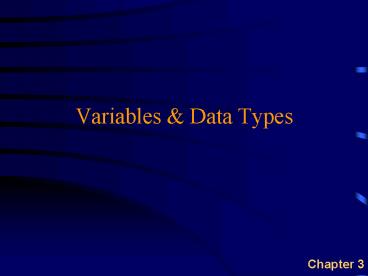Variables - PowerPoint PPT Presentation
1 / 15
Title:
Variables
Description:
Append, insert, extract. Boolean. True or False, like the visible property. 4 ... Variables are named containers of data. They are not displayed on a form ... – PowerPoint PPT presentation
Number of Views:12
Avg rating:3.0/5.0
Title: Variables
1
Variables Data Types
Chapter 3
2
Overview
- Variables
- Data Types
- Expressions
- Type conversion
- VB IDE issues
- Dealing with long lines of code
- Comments
3
Types of Data
- Numeric
- Can contain only numbers
- Real numbers, integers, currency, dates
- Used for arithmetic calculations
- String (text)
- May contain any symbol
- No arithmetic calculations
- Append, insert, extract
- Boolean
- True or False, like the visible property
4
Variables - The Concept
- Variables are named containers of data
- They are not displayed on a form
- Their contents can change (vary) during runtime
- Variables are grouped by size and purpose
- Some types of data require more memory than
others - Each variable belongs to a type
- The type of a variable determines
- Size
- How operators will work on the variable
- Add, subtract, append, logical NOT
5
VB Variables
- Variables are not created using the tool box
- Instead, they are declared within the program
- Declaring a variable
- sets aside memory for the variable
- assigns a name to that space in memory
- describes what type of data can be stored there
- Variables dont work with the properties window
- Changes to a variable must be made in a program
6
Declaring a Variable
- A declaration begins with the Dim statement
- This alerts VB that a new variable is being
defined - A declaration contains a variable name and type
- Just as each control must have a (name), like
lblInput, and type, like label - The form of a declaration Dim ltnamegt as lttypegt
- For example
- Dim intCount as Integer
7
Numeric Variable Types
- There are several different numeric variable
types, each with varying - Precision
- Size
- Representation scheme
- Selecting the wrong type for variables can hurt
the performance of a program
8
Counting Things
- Integer types
- BYTE ? Small range of values, 0 to 255
- INTEGER ? -32,768 to 32,767
- 2 bytes
- LONG ? -2,147,483,648 to 2,147,483,647
- 4 bytes
9
Measuring Things
- SINGLE
- Positive or negative
- As close to zero as 1.401298E-45
- As large as 3.402823E38
- 4 bytes
- DOUBLE
- Positive or negative
- As close to zero as 4.94065645841247E-327
- As large as 1.79769313486232E308
- 8 bytes
10
Highest Precision
- Scaled integers
- CURRENCY
- /-922,337,203,685,477.5807
- 8 bytes
- DECIMAL
- /-79,228,162,514,262,337,593,543,950,335
- /-7.9228162514262337593543950335
- no rounding, slow but exact to precision limit
- 14 bytes
11
Storage Space Prefixes
- BYTE 1 byte byt
- INTEGER 2 bytes int
- LONG 4 bytes lng
- SINGLE 4 bytes sng
- DOUBLE 8 bytes dbl
- BOOLEAN 2 bytes bln
- CURRENCY 8 bytes cur
- DECIMAL 14 bytes dec
12
Operators and Expressions
- As in algebra, VB variables can be connect with
operators to form expressions - An expression, like a variable, has a value and a
type - For exampleDim intValue as IntegerDim sngValue
as SingleintValue 4sngValue
1.25lblOuput.Caption 4intValue sngValue
Expression Type Single, Value 17.25
Assignment Statement
13
Assignment and Type
- It is possible for an assignment statement to
have a variable of one type on the left of the
equal sign, and an expression of another type on
the right - Also, sometimes an operator is used on 2
variables of different type - In both these cases, VB will convert the values
to the most appropriate type - Type conversion rules get pretty complex, so
we'll focus on simple, common results
14
Automatic Type Conversion
- Dim intValue as integer
- intValue 12
- intValue "12"
- intValue 12.5
- intValue 11.51
- Due to automatic type conversion, all these
statements result in the integer variable
intValue being set to 12
15
Variable Scope
- A variable has a scope, the area it is accessible
- Variables can be declared inside of a sub
- These are said to be local variables
- They cannot be accessed outside the sub
- They are re-initialized each time the sub is
called - Variables declared outside of any procedure are
global - Can be used in any code on that form
- Values are preserved between button clicks
Dim intCount As Integer Private Sub
cmdOn_Click() Dim intSlot as Integer
lblOut.Caption _ intCount intSlot End Sub

